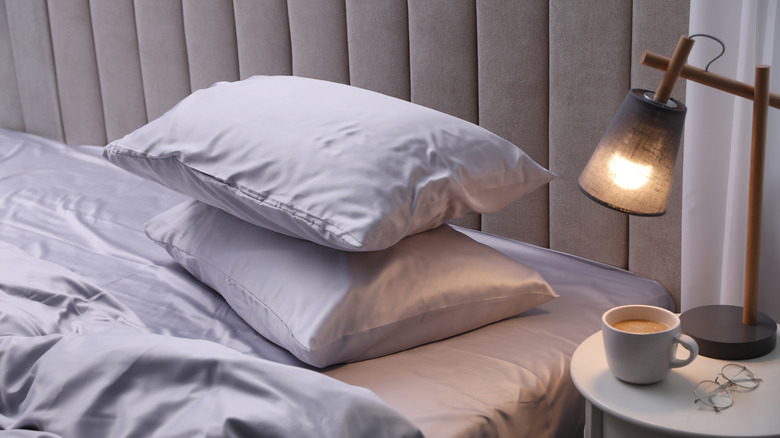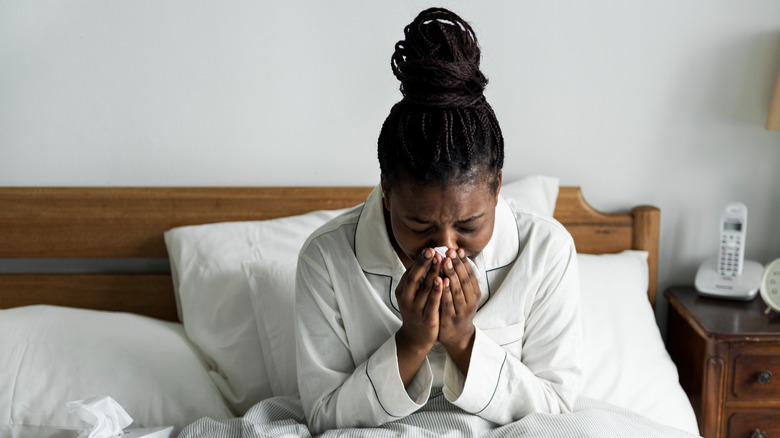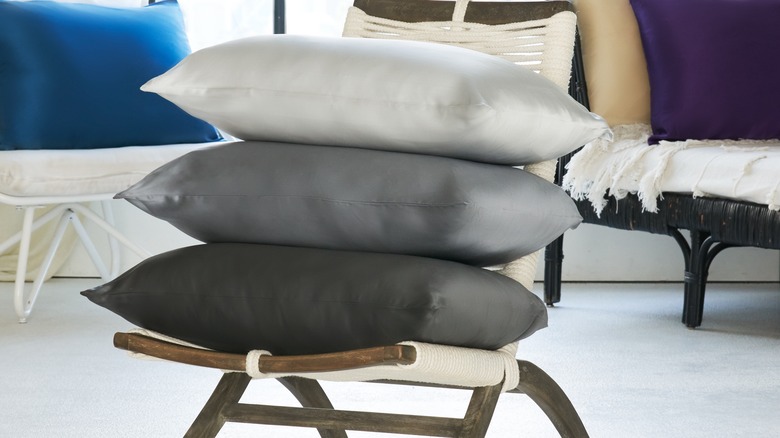Here's How Often You Should Be Washing Your Pillowcases
There's at least 15 million reasons to launder our pillowcases on a regular basis, because that's how many dead skin cells we shed each night while we sleep, according to Business Insider. These end up on our sheets and pillowcases along with everything else we're exposed to during the day — pollen, dirt, mold spores, pet hair, various products, and more. By the end of the week, even if our bedding still looks clean and smells fresh, it's teeming with bacteria. So much bacteria, in fact, that samples taken from a used pillowcase are indistinguishable from those of a toilet seat. The Smithsonian Magazine reports that our pillowcases are covered with gut microbes, which essentially means we rest our heads on fecal matter.
Millions of microscopic dust mites can also be found in the average bed, feasting on those dead skin cells and wreaking havoc on allergy sufferers. The American Lung Association reports that if you have a stuffy nose after being in bed all night, you likely have a dust mite allergy, meaning your body is triggered by inhaling mites as they decompose, as well as a protein that comes from their feces and urine.
Kind of makes you want to strip your bedding and wash it pronto, right? Some of us can get away with laundering pillowcases once a week, but Sleep Sources says most people wash or change their bed linens, on average, every 24 days. However, there are some folks who should consider cleaning them more often.
Determining your wash schedule
Washing pillowcases in hot water once per week is important for health reasons. According to Business Insider, bacteria and up to 16 different fungal species build up in the fabric. In turn they can cause or worsen acne, asthma, allergies, and other potentially serious health issues. People who suffer from these conditions should wash their pillowcases more frequently, maybe as often as every two or three days, says Piles of Pillows.
When shopping for bedding, select a fabric for its comfort, but also consider its characteristics when it comes to hygiene and cleaning. Cotton, the most popular, is easy to care for and comes in a variety of textures. It collects oils and debris though, so it's important to properly follow care instructions. Cotton blends are also common, affordable, and easy to maintain. Other popular fabrics, according to Piles of Pillows, are satin, silk, linen, and nylon. Washing pillowcases more often than the sheets they go with may result in color differences. To avoid this problem, buy additional matching pillowcases and alternate them so each is washed less frequently.
In addition to fabric, other factors include the weather in your area, your activity level, and how much you sweat. Also consider whether you shower before going to bed, the facial and hair care products you use, time spent outdoors, and household pets — especially animals who are allowed on the bed.
Pillows get dirty too
The same contaminants and allergens that saturate bedding eventually find their way to the pillows and mattress. High quality coverings that are designed to go under the bed linens can help preserve cleanliness. Even so, these protectors also need to be washed, which is why Gotta Sleep recommends tossing them in the machine with your sheets. Pillows protected by zippered covers can be laundered twice per year, says Best Pillow Sleepers, but it still depends on other factors. If you notice staining on the pillows when you remove the coverings, that's a sign that sweat, oils, and saliva are seeping through. Spot treat stains and wash pillows every two or three months. This schedule also applies to pillows used without protective coverings under the pillowcases.
Most pillows — cotton, down, polyester, and those with feathers — are machine washable, says Reader's Digest, but not all. So, follow the care instructions on the tag carefully. It's important to look for any broken seams and repair them beforehand. It is recommended by the Sleep Foundation to replace pillows every one to two years.


